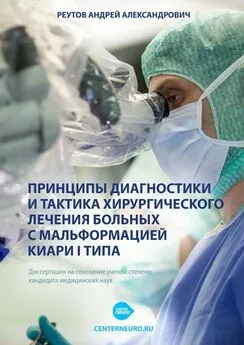Дмитрий Окишев - Хирургическое лечение каверном полушарий большого мозга. Анализ ближайших и отдаленных результатов лечения
- Название:Хирургическое лечение каверном полушарий большого мозга. Анализ ближайших и отдаленных результатов лечения
- Автор:
- Жанр:
- Издательство:неизвестно
- Год:2016
- ISBN:978-5-4483-3412-2
- Рейтинг:
- Избранное:Добавить в избранное
-
Отзывы:
-
Ваша оценка:
Дмитрий Окишев - Хирургическое лечение каверном полушарий большого мозга. Анализ ближайших и отдаленных результатов лечения краткое содержание
Хирургическое лечение каверном полушарий большого мозга. Анализ ближайших и отдаленных результатов лечения - читать онлайн бесплатно ознакомительный отрывок
Интервал:
Закладка:
Практические рекомендации
Всем больным с подозрением на каверному полушарий большого мозга должна быть выполнена МРТ в стандартных режимах. Для более точной диагностики, определения прогноза и дальнейшей тактики ведения больного желательно дополнять исследование режимом Т2* (GRE).
В связи с зависимостью исходов лечения эпилепсии от длительности анамнеза болезни, больной с подозрением на каверному полушарий большого мозга должен быть обследован и консультирован в специализированном медицинском учреждении в ближайшее время после манифестации заболевания.
В связи с относительными показаниями к хирургическому лечению кавернозных ангиом во многих случаях больной должен быть полностью информирован о вариантах течения болезни и возможных рисках хирургического лечения.
В случае наличия факторов, ухудшающих прогноз лечения эпилепсии, рекомендуется рассматривать использование дополнительных хирургических опций: резекции функционально измененной коры под контролем ЭКоГ, в случае наличия доказанной эпилептической активности в медиальных отделах височной доли — амигдалогиппокампэктомии.
В связи особенностями эпилептического синдрома при каверномах головного мозга, срок послеоперационного наблюдения для оценки результатов лечения эпилепсии должен быть не менее 2 лет с момента операции.
Список литературы
1. Амиридзе Н. Ш. Каверномы головного мозга. Клиника, диагностика и хирургическое лечение: Дис. канд. мед. наук. — М., 1993.
2. Белоусова О. Б., Шишкина Л. В., Филатов Ю. М., Сазонова О. Б. Супратенториальные каверномы: клиническая картина, диагностика, лечение // Журнал Вопросы нейрохирургии им. Н. Н. Бурденко. — 2003. — №1. — С. 2—7.
3. Зенков Л. Р., Ронкин М. А. Функциональная диагностика нервных болезней. — М.: МЕДпресс-информ, 2004.
4. Карлов В. А. Эпилепсия. — М.: Медицина, 1990. — 205 с.
5. Медведев Ю. А., Мацко Д. Е. Аневризмы и пороки развития сосудов головного мозга. — СПб., 1993. — Т. 2. — С. 14—28.
6. Мухин К. Ю, Петрухин А. С, Глухова Л. Ю. Эпилепсия. Атлас электро-клинической диагностики. — М: Альварес Паблишинг, 2004.
7. Ремезова Е. С. Дифференциальное лечение больных эпилепсией. — М.: Медицина, 1965.
8. Abdulrauf S. I., Kaynar M. Y., Awad I. A. A comparison of the clinical profile of cavernous malformations with and without associated venous malformations. Neurosurgery. 1999 Jan; 44 (1): 41—6; discussion 46—7.
9. Aguilera D., Tomita T., Goldman S., Fangusaro J. Incidental resolution of a radiation-induced cavernous hemangioma of the brain following the use of bevacizumab in a child with recurrent medulloblastoma. Pediatr Neurosurg. 2010; 46 (4): 303—7. Epub 2010. Dec 30.
10. Aiba T., Tanaka R., Koike T., Kameyama S., Takeda N., Komata T. Natural history of intracranial cavernous malformations. Neurosurg 83: 56—59, 1995.
11. Amin-Hajani S., Ogilvy C. S., Ojemann R. G., Crowell R. M. Risk of surgical management for cavernous malformations of the nervous system. Neurosurg 42, 1220—1228, 1998.
12. Awad I. A., Robinson J. R. Cavernous malformations. In: Awad IA, Barrow DL, eds. Park Ridge, IL: AANS; 1993: 49—63.
13. Awad I. A., Rosenfeld J., Ahl J. et al. Intractable epilepsy and structural lesions of the brain: mapping, resection strategies, and seizure outcome. Epilepsia. 1991 Mar—Apr; 32 (2): 179—86.
14. Barker F. G. 2nd, Amin-Hanjani S., Butler W. E. et al. Temporal clustering of hemorrhages from untreated cavernous malformations of the central nervous system. Neurosurgery. 2001 Jul; 49 (1): 15—24; discussion 24—5.
15. Batra S., Lin D., Recinos P. F., Zhang J., Rigamonti D. Cavernous malformations: natural history, diagnosis and treatment. Nat Rev Neurol 5: 659—670, 2009.
16. Baumann C. R., Acciarri N., Bertalanffy H. et al. Seizure outcome after resection of supratentorial cavernous malformations: A study of 168 patients. Epilepsia 48: 559—563, 2007.
17. Berg A. T., Berkovic S. F., Brodie M. J. et al. Revised terminology and concepts for organization of seizures and epilepsies: report of the ILAE Commission on Classification and Terminology, 2005—2009. Epilepsia. 2010 Apr; 51 (4): 676—85. Epub 2010. Feb 26.
18. Bergstrand A., Olivecrona H., Tonnis W. Gefassmissbildungen und Gefassgeschwulste des gehirns in Germany, Leipzig, Georg Thieme, 1936.
19. Bertalanffy H., Gilsbach J. M., Eggert H. R., Seeger W. Microsurgery of deep-seated cavernous angiomas: report of 26 cases. Acta Neurochir (Wien). 1991; 108 (3—4): 91—9.
20. Bicknell J. M., Carlow T. J., Kornfeld M. et al. Familial cavernous angiomas. Arch Neurol 35: 746—749, 1978.
21. Broggi G., Ferroli P., Franzini A. Cavernous Malformations and Seizures: Lesionectomy or Epilepsy Surgery? Lanzino G, Spetzler RF (eds): Cavernous Malformations of the Brain and Spinal Cord. N. Y.: Thieme, 2008.
22. Cantu C., Murillo-Bonilla L., Arauz A., Higuera J., Padilla J., Barinagarrementeria F. Predictive factors for intracerebral hemorrhage in patients with cavernous angiomas. Neurol Res 27: 314—318, 2005.
23. Cappabianca P., Alfieri A., Maiuri F. et al. Supratentorial cavernous malformations and epilepsy: seizure outcome after lesionectomy on a series of 35 patients. Clin Neurol Neurosurg 99: 179—183, 1997.
24. Casazza M., Broggi G., Franzini A. et al. Supratentorial cavernous angiomas and epileptic seizures: preoperative course and postoperative outcome. Neurosurgery. 1996; 39 (1): 26—32.
25. Chang E. F., Gabriel R. A., Potts M. B. et al. Supratentorial cavernous malformations in eloquent and deep locations: surgical approaches and outcomes. J Neurosurg. 2010. Jul 2.
26. Clatterbuck R. E., Eberhart C. G., Crain B. J., Rigamonti D. Ultrastructural and immunocytochemical evidence that an incompetent blood-brain barrier is related to the pathophysiology of cavernous malformations. J Neurol Neurosurg Psychiatry 71: 188—192, 2001.
27. Clatterbuck R. E., Moriarity J. L., Elmaci I., Lee R. R., Breiter S. N., Rigamonti D. Dynamic nature of cavernous malformations: a prospective magnetic resonance imaging study with volumetric analysis. J Neurosurg 93: 981—986, 2000.
28. Cohen D. S., Zubay G. P., Goodman R. R. Seizure outcome after lesionectomy for cavernous malformations. J Neurosurg 83: 237—242, 1995.
29. Commission on Classification and Terminology of the International League Against Epilepsy. Proposal for revised clinical and electroencephalographic classification of epileptic seizures. Epilepsia 22: 4898—501, 1981.
30. Cosgrove G. R. Occult vascular malformations and seizures. Neurosurg Clin N Am 10: 527—535, 1999.
31. Craig H. D., Günel M., Cepeda O., Johnson E. W., Ptacek L., Steinberg G. K. et al: Multilocus linkage identifies two new loci for a mendelian form of stroke, cerebral cavernous malformation, at 7. P. 15—13 and 3q25. 2—27. Hum Mol Genet 7: 1851—1858, 1998.
32. Dandy W. E. Venous abnormalities and angiomas of the brain. Arch Surg 17: 715—793, 1928.
33. de Souza J. M., Domingues R. C., Cruz L. C. Jr. et al. Susceptibility-weighted imaging for the evaluation of patients with familial cerebral cavernous malformations: a comparison with t2-weighted fast spin-echo and gradient-echo sequences. AJNR Am J Neuroradiol. 2008 Jan; 29 (1): 154—8. Epub 2007 Oct 18.
34. Deistung A., Rauscher A., Sedlacik J. et al. Susceptibility weighted imaging at ultra high magnetic field strengths: theoretical considerations and experimental results. Magn Reson Med. 2008 Nov; 60 (5): 1155—68.
35. Del Curling O., Kelly D. L., Elster A. D., Craven T. E. An analysis of the natural history of cavernous angiomas. J Neurosurg. 1991; 75 (5): 702—708.
36. Devinski O. Seizure diksorders. Clinical symposia, 1994. — V. 41. — P. 1—33.
37. Dubovsky J., Zabramski J. M., Kurth J., Spetzler R. F., Rich S. S., Orr H. T. et al. A gene responsible for cavernous malformations of the brain maps to chromosome 7q. Hum Mol Genet 4: 453—458, 1995.
38. Engel J. Jr., Van Ness P. C., Rasmussen T. B., Ojemann L. M. Outcome with respect to epileptic seizures, in Engel J Jr (ed): Surgical Treatment of the Epilepsies. — N. Y.: Raven Press, 1993. Ed 2. — Pp. 609—622.
39. Engel J. Jr. A Proposed Diagnostic Scheme for people with Epileptic Seizures and with Epilepsy. Report of the ILAE Task Force on Classification and terminology. Epilepsia 42: 796—803, 2001.
40. Er U., Spetzler R. F., Cardia A., Lanzino G., Deep-Seated Cerebral Cavernous Malformations. In: Lanzino G, ed., Spetzler RF, ed. Cavernous Malformations of the Brain and Spinal Cord. Thieme; 2007: 71—77.
41. Estes M. L., Morris H. Hr., Luders H. et al. Surgery for intractable epilepsy. Clinicopathologic correlates in 60 cases. Cleveland Clinic Journal of Medicine 55: 441 —447, 1998.
42. Ferrier C. H., Aronica E., Leijten F. S. et al. Electrocorticography discharge patterns in patients with a cavernous hemangioma and pharmacoresistent epilepsy. J Neurosurg. 2007 Sep;107 (3): 495—503.
43. Flemming K. D., Goodman B. P., Meyer F. B. Successful brainstem cavernous malformation resection after repeated hemorrhages during pregnancy. Surg Neurol. 2003 Dec; 60 (6): 545—7; discussion 547—8.
44. Folkersma H., Mooij J. J. Follow-up of 13 patients with surgical treatment of cerebral cavernous malformations: effect on epilepsy and patient disability. Clin Neurol Neurosurg 103: 67—71, 2001.
45. Frerich K. U., Stieg P. E., Friedlander R. M. Classification and Grading Systems. Stieg P. E., Batjer H. H., Samson D. (eds): Intracranial Arteriovenous Malformations. N. Y.: Informa Healthcare, 2007.
46. Garner T. B., Del Curling O. Jr., Kelly D. L. Jr., Laster D. W. The natural history of intracranial venous angiomas. J Neurosurg. 1991 Nov; 75 (5): 715—22.
47. Gil-Nagel A., Dubovsky J., Wilcox K. J., Stewart J. M., Anderson V. E., Leppik I. E. et al: Familial cerebral cavernous angioma: a gene localized to a 15-cM interval on chromosome 7q. Ann Neurol 39: 807—810, 1996.
48. Gralla J., Ganslandt O., Kober H. et al. Image-guided removal of supratentorial cavernomas in critical brain areas: application of neuronavigation and intraoperative magnetic resonance imaging. Minim Invasive Neurosurg. 2003 Apr; 46 (2): 72—7.
Читать дальшеИнтервал:
Закладка:










